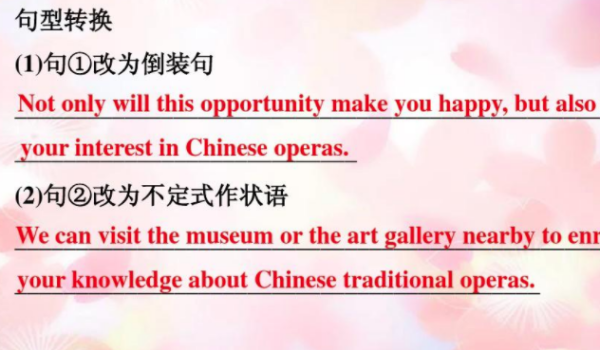本文目录
不定式做目的状语
不定式做目的状语的用发:跟在不及物动词后面。stop to have a rest停下来休息一会。eat to live,but not live to eat吃是为了活着,可活着不是为了吃。动词不定式常作目的状语。
不定式作状语用于句末表示目的,条件,原因,方式及结果
例1:She sold her hair to buy the watch chain. (目的状语)
为了买回那个表带,她把头发卖了。

注:不定式作目的状语的位置比较灵活,可以放在句子主体结构的前面,也可以放在句子主体结构的后面。这句话也可以改为:To buy the watch chain, she sold her hair.
例2:I would have been crazy to be told about it. (条件状语)
要是我知道我会疯的。

注:这句话可使用条件状语从句改写为:I would have been crazy if I had been told about it.
例3:I am really honored to be invited. (原因状语)
我很高兴能被邀请。
动词不定式做目的状语的结构
英语中的动词不定式具有副词的功能,可以在句子中作状语,表示多种意义.在这里就动词不定式作目的状语进行单独讨论.
一、不定式和不定式短语作目的状语
不定式和不定式短语作目的状语,主要用来修饰动词,表示某一动作或状态的目的.为了使目的意义更加清楚或表示强调意义时,还可以在前面加 in order to 或 so as to.例如:
I've written it down in order not to forget.
He shouted and waved so as to be noticed.
在句子中作谓语动词的状语的不定式或不定式短语,表示的是主语的目的,因此,其逻辑主语通常是句子的主语.比较:
To draw maps properly,you need a special pen.(正)
To draw maps properly,a special pen is needed.(误)
由 in order to 引导的目的状语,既可以置于句尾,也可以置于句首,而由 so as to 引导的目的状语,只能置于句尾,而不能置于句首.比较:
They started early in order to get there in time.(正)
In order to get there in time,they started early.(正)
They started early so as to get there in time.(正)
So as to get there in time,they started early.(误)
二、不定式的复合结构作目的状语
当不定式或不定式短语有自己的执行者时,要用不定式的复合结构(即在不定式或不定式短语之前加 for + 名词或宾格代词)作状语.例如:
He opened the door for the children to come in.
She fetched several bottles which she placed on the counter for Harry to inspect.
三、目的状语从句与不定式的转换
英语中的目的状语从句,还可以变为不定式或不定式短语作状语,从而使句子在结构上得以简化.可分为两种情况:
1.当目的状语从句中的主语与主句中的主语相同时,可以直接简化为不定式或不定式短语作状语.例如:
We'll start early in order that/so that we may arrive in time.
We'll start early in order to/so as to arrive in time.
2.当目的状语从句中的主语与主句中的主语不相同时,要用动词不定式的复合结构作状语.例如:
I came early in order that you might read my report before the meeting.
I came early (in order) for you to read my report before the meeting.

不定式的to是表目的
第一个to为动词不定式,但不是表示目的的,而是接在动词后面作宾语。
动词不定式有两种,一种是带to的不定式,一种是不带to的动词不定式。不带to的动词不定式就是动词原形。
动词不定式有一般式、完成式、进行式、完成进行式。它可以在句子中作主语,也可以放在be动词后面作表语,还可以放在一般动词后面作宾语,还可以放在名词后面作定语,当作定语的名词与动词不定式之间是动宾关系时,称为反射不定式。
动词不定式还可以作状语,可以表示目的、原因、条件等,可以放在句首、句中和句末的位置。

疑问词+动词不定式的用法
1.作主语
作主语用的动词不定式常常用it替代,动词不定式(或短语)放在后面。例如:
It's easy to get lost in a big city like Tokyo.在东京这样的大城市容易迷路。
It is terrible to see the ship sinking into the sea.目睹轮船沉入大海,真是太可怕了。
2.作宾语
Indians like to eat hot food.印度人喜欢吃辣味食品。
They need to look at a map.他们需要查看地图。
有的动词不定式在作带有补足语的宾语时,前面往往带有形式宾语it。例如:
Do you think it necessary for us to learn to wait?你认为学会等待对我们来说很必要吗?
They improved the software to make it easier for people to use computers.他们改进了软件,使人们使用计算机更简便了。
3.作表语
It seems to be an interesting book.它看起来是本有趣的书。
The old man's job is to take care of the flowers in the garden.这位老人的工作是照料花园里的花。
4.作宾语补足语
He told me not to bring you anything.他叫我不要给你带任何东西。
Who taught you to play the music?谁教你弹这支曲子的?
5.作定语
动词不定式作定语时,要放在它所修饰的名词或代词后面。例如:
In my dreams I always have very difficult jobs to do.我在梦里总是做一些艰难的工作。
Every day he made one of the smaller animals bring him something to eat.他每天叫一个小动物给他带来吃的东西。
6.作状语
(1)表示目的
You can hide under my seat when the conductor comes to check the tickets.当列车员来查票时,你可以藏在我的座位下面。
In his third year,he left Harvard to work for a company called Microsoft.在三年级时,他为了去微软公司工作而离开了哈佛大学。
(2)表示结果
动词不定式作状语表示结果时常与副词too或enough连用。例如:
It's too heavy to carry.太重了搬不动。
The Californian ship arrived too late to save more people.加利福尼亚号来得太晚,没能挽救更多的人。
7.和某些形容词连用
和动词不定式经常连用的形容词有sure,ready,happy,sorry,afraid等。例如:
He's very happy to see his wife.他见到妻子非常高兴。
I'm sorry to trouble you.很抱歉打扰你了。
8.和疑问词who,what,when,where,which,how构成不定式短语作宾语。例如:
I don't know how to use a computer.我不知道怎样使用计算机。
Can you tell me when to start?你能告诉我什么时候出发吗?

以上就是关于动词不定式表目的举例 ,不定式做目的状语的全部内容,以及动词不定式表目的举例 的相关内容,希望能够帮到您。

